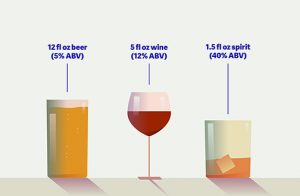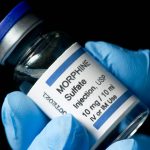Hard seltzer is a mixture of alcohol and seltzer. However, it is different from other spirits sold in stores. It is a sugar-brew made from fermented cane sugar instead of grain or wheat, meaning it has a lower alcohol-by-volume percentage. Most spirits are typically made from grains. An example is Vodka, which is made from fermented grains like rice and corn. Even though hard seltzer has frequently been compared to soda and vodka beverages, they are not the same. Hard seltzer does not have distilled spirits like Vodka in it, but it is made the same way as beer.
Defining Alcohol Content of Alcoholic Drinks.
 The alcohol content of a drink is typically measured through ABV or alcohol by volume. ABV is the volume of ethanol as a percentage of the overall volume of a beverage. For example, the average ABV for hard seltzer is 4-6 %, while it is 40% or even higher for Vodka. The alcohol level in a beverage depends on how it is made. Alcoholic drinks all rely on fermentation, which is a process that transforms sugars into alcohol using yeast. The fermentation process for wine is longer than that of beer as it takes longer for the yeast to break down the sugar in grapes to produce alcohol. The yeast determines the alcohol content, and for beer fermentation, the yeast usually becomes inactive once the alcohol content rises above 10 percent. Liquor or spirits go through an extra process to achieve their high alcohol content. After fermentation, they undergo distillation to separate the alcohol from the water, generating an alcohol content of at least 20 percent.
The alcohol content of a drink is typically measured through ABV or alcohol by volume. ABV is the volume of ethanol as a percentage of the overall volume of a beverage. For example, the average ABV for hard seltzer is 4-6 %, while it is 40% or even higher for Vodka. The alcohol level in a beverage depends on how it is made. Alcoholic drinks all rely on fermentation, which is a process that transforms sugars into alcohol using yeast. The fermentation process for wine is longer than that of beer as it takes longer for the yeast to break down the sugar in grapes to produce alcohol. The yeast determines the alcohol content, and for beer fermentation, the yeast usually becomes inactive once the alcohol content rises above 10 percent. Liquor or spirits go through an extra process to achieve their high alcohol content. After fermentation, they undergo distillation to separate the alcohol from the water, generating an alcohol content of at least 20 percent.
The proof of an alcoholic drink can also measure its alcohol content. The alcohol proof is a different unit of measurement from Alcohol By Volume or ABV, which quantifies the alcohol in a bottle compared to the overall volume of liquid. The proof is usually twice the ABV of an alcoholic drink. So if Vodka has an ABV of 40 percent, its proof is 80. US drinkers can also describe the potency of any liquor using the proof.
Hard Seltzer Alcohol Content
 Hard seltzer is made by adding a bit of sugar to the seltzer or carbonated water and introducing yeast to the mixture to start the fermentation process. During fermentation, the sugars in the mix are then converted into alcohol, and the drink is infused with artificial or natural flavors.
Hard seltzer is made by adding a bit of sugar to the seltzer or carbonated water and introducing yeast to the mixture to start the fermentation process. During fermentation, the sugars in the mix are then converted into alcohol, and the drink is infused with artificial or natural flavors.
Each hard seltzer brand has its way of making the drink, with some using other fermentable bases such as rice or barley. The idea behind hard seltzers is to develop a low-carb, low-calorie sparkling alcoholic beverage that is low in sugars. Most of these hard seltzers are also gluten-free.
Vodka Alcohol Content
 On the other hand, Vodka is a popular liquor used in shots, mixed beverages, and cocktails, making it a bar essential. It originated from Russia and is frequently referred to as a neutral grain spirit as it is typically made by fermenting grain and distilling it. According to the distiller’s choice, grains used for the process may include wheat, rye, or corn. You can distill Vodka from almost anything, including milk, potatoes, grapes, and beets. As a rectified spirit, Vodka is usually distilled a minimum of three times, with some being distilled even five times or more. Vodka is assumed to be smoother and cleaner the more it is filtered, which is true. Each distillation removes the unwanted parts of the distillate found at the bottom and top of the completed batch, leaving only the essence of the extract, making the Vodka purer and cleaner. Following distillation, the Vodka can be filtered again, typically through charcoal. Vodka does not need to age and can be taken immediately. However, it is cut with water ranging from bottling proof to still strength, making Vodka 40 percent ABV or 80 proof. You can also find 100-proof Vodka or even higher.
On the other hand, Vodka is a popular liquor used in shots, mixed beverages, and cocktails, making it a bar essential. It originated from Russia and is frequently referred to as a neutral grain spirit as it is typically made by fermenting grain and distilling it. According to the distiller’s choice, grains used for the process may include wheat, rye, or corn. You can distill Vodka from almost anything, including milk, potatoes, grapes, and beets. As a rectified spirit, Vodka is usually distilled a minimum of three times, with some being distilled even five times or more. Vodka is assumed to be smoother and cleaner the more it is filtered, which is true. Each distillation removes the unwanted parts of the distillate found at the bottom and top of the completed batch, leaving only the essence of the extract, making the Vodka purer and cleaner. Following distillation, the Vodka can be filtered again, typically through charcoal. Vodka does not need to age and can be taken immediately. However, it is cut with water ranging from bottling proof to still strength, making Vodka 40 percent ABV or 80 proof. You can also find 100-proof Vodka or even higher.
Compared to Vodka, hard seltzer has a significantly lower alcohol percentage per serving of about 4-6%. Vodka typically has 40% alcohol by volume, so you would need a vodka/water ratio of one to seven to make an equally potent cocktail as a hard seltzer. This indicates that Vodka on its own is much stronger than hard seltzer based on the alcohol by volume content.
Hard seltzer’s combination of spirits and carbonated soda makes it a lower-alcohol option. Based on how much mixer you add to your Vodka, a hard seltzer could offer less alcohol per drink to the drinker. Any soda-infused alcoholic beverage could give you a rush to the head if you take a significant number of drinks. This is because the body absorbs carbonated alcoholic drinks like hard seltzers to the bloodstream much faster. Thus, one may experience the effects much quicker, especially if they drink on an empty stomach.
The sweetness of hard seltzers compared to Vodka also means people tend to drink them very fast without realizing the amount of alcohol they are taking. This causes one’s blood alcohol levels to increase and the drinks to add up in the bloodstream over a short period. Vodka sodas are typically unsweetened when served, causing drinkers to take them more slowly over a long time in one sitting. However, sweet vodka cocktails would present the same issue as hard seltzers. You would drink too much in a short period due to the pleasant taste, and before you know it, you are intoxicated.
The key with both hard seltzer and Vodka is to pace oneself accordingly when drinking them. Since Vodka is the strongest of the two, unsweetened vodka beverages are ideal as they help you drink slower. You also need to be more aware of how many hard seltzers you take, considering how sweet they are and how easy it is to get carried away drinking them.


